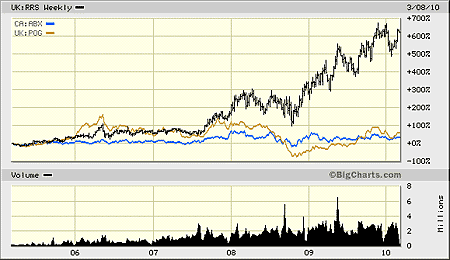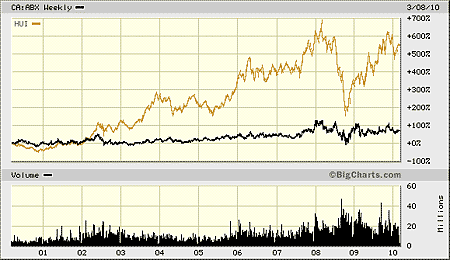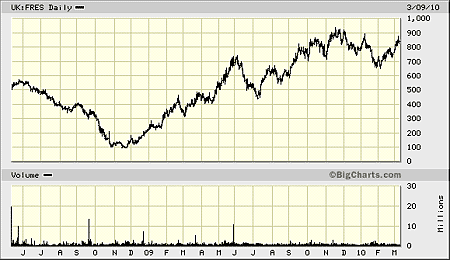Should you buy into Barrick Gold's big London listing?
Barrick, the world's largest gold producer, is to list its African unit in a London IPO. With gold still firmly in a bull market, is this something you should be buying into? Or is it one to avoid? Dominic Frisby investigates.
I can remember back in 2004, sipping wine with a French friend, looking out at the sea off the South-West coast of France, and explaining why he should buy gold.
Whether it was the wine or my argument that persuaded him, he was convinced. He announced that the following morning he would buy options on Barrick, the world's largest gold producer.
I never found out if he made the purchase or not. I hope he didn't. Gold was a buy. But the world's largest gold producer wasn't. I'll explain why in a moment.
MoneyWeek
Subscribe to MoneyWeek today and get your first six magazine issues absolutely FREE

Sign up to Money Morning
Don't miss the latest investment and personal finances news, market analysis, plus money-saving tips with our free twice-daily newsletter
Don't miss the latest investment and personal finances news, market analysis, plus money-saving tips with our free twice-daily newsletter
But now Barrick is selling shares of its African unit in a London IPO. Is this a company goldbugs - and my French friend - should be looking to buy now? Or is it one to avoid?
How does Barrick compare to London's other listed miners?
Barrick Gold is seeking to raise as much as £650m by selling shares of its African unit in a London IPO. About 100 million shares, priced somewhere between 550 and 650 pence will be sold, making up around 25% of Barrick's African unit.
Should the shares sell at the upper end of that range, that will give African Barrick Gold an overall market cap of somewhere around the £2.5bn mark. The company is expected to produce around 825,000 ounces of gold this year, with reserves of 16.8m ounces. It is targeting an increase in production to over a million ounces by 2014.
For some perspective, let's compare that to London's other listed senior producers. Randgold Resources (LSE: RRS) has a market cap of £4.6bn with a projected gold output of about 450,000 ounces this year, rising to a projected 1m-plus ounces for 2013. And Petropavlovsk Plc (LSE: POG), formerly Peter Hambro, is valued at £1.9bn, with production in 2009 at just under 500,000 ounces, projected to rise by 2012 to around 1m ounces.
Ignoring cash costs per ounce, which is a minefield I don't want to get into here (largely speaking Petropavlovsk's are the cheapest), Barrick Africa does not look bad value at these prices nor does Petropavlovsk. But talk to the shareholders of the three companies and the happiest with management will be Randgold's. It's been a star.
In the chart below, the black line shows Randgold over the last five years, the yellow line Petropavlovsk and the blue line Barrick. The last two have barely moved, despite the bull market in gold, while Randgold is up some 600%.

Hedging gold production doesn't pay in a bull market
Barrick clearly knows how to build and run a mine. You don't become the world's largest producer by accident. But the company's share price has been a disappointment. Much of this failure has to do with Barrick's policy of hedging its gold production. In other words, the company would sell future gold production at current prices.
This worked wonderfully in the bear market of the 1980s and 1990s, as the gold price fell. In fact, it actually helped Barrick to become the world's largest producer, as its rivals disappeared. But hedging has been a disaster since 2001, simply because gold prices have been rising.
Here is Barrick's share price (black line) over the last ten years compared to the HUI (yellow line), which is the index of unhedged US gold miners.

My French friend's options would probably have expired worthless. The HUI is up by more than 500%, whereas Barrick has barely appreciated 80%. But note how Barrick outperformed the HUI during the bear market of 2000, and in the crash of 2008.

- Why UK property prices are going to fall 50%
- When it will be time to get back in and buy up half price property
This is one reason I'm not crazy about the London-listed exchange-traded fund AUCO, which tracks the Russell Global Gold index. It's too exposed to companies like Barrick who hedge, or at least used to hedge, their gold. This may protect in a bear market, but it minimises your upside during a bull market. I like to see more enthusiasm from management about the company's end product.
Barrick only abandoned its hedging strategy late last year. It appears to have taken management eight years to recognise this gold bull market for what it is. I expect it took so long partly because it always takes longer for large companies, like large ships, to change course; and partly because hedging had worked so well in the '90s, so it was hard to let it go.
Don't buy Barrick, but keep it on your watch list
Whatever the reason, despite the competitive valuations and the apparent change in strategy, I am not inspired to rush out and buy Barrick Africa. That may be harsh on my part. But I prefer smaller, nimbler companies. Ones that, I admit, will perish in a bear market. But I intend to be long gone by then. Indeed one question Barrick's shareholders should be asking is how long will it take management to recognise that the bull market is over, as one day it eventually will be?
I see some parallels between the listing of Barrick Africa and the listing in the summer of 2008 of Fresnillo, the world's largest silver producer and Mexico's second-largest gold producer. Fresnillo couldn't have listed at a worse time, just as panic was starting to grip world stock markets. It fell by 80%, within a few months after listing, from 500p to 100p (see the chart below). It is now trading at above 800p. I doubt we'll see that kind of volatility with African Barrick, but it's worth being aware of what's possible.

So I won't be buying any stock in African Barrick - not straight away at least - but I'll be watching it. If nothing else, it's excellent to have another gold producer in the FTSE 100. It's good for London and should also be good for gold. We need increased awareness of gold and gold shares among the many dozy institutions who have let this bull market pass them by those same institutions who probably still like the builders, the financials and UK gilts.
Our recommended article for today
One Latin American market for the bold
Over the last few decades, Colombia has acquired a reputation for violence and corruption. But now it is rapidly becoming a bright spot for investors in Latin America, says Andrey Dashkov.
Get the latest financial news, insights and expert analysis from our award-winning MoneyWeek team, to help you understand what really matters when it comes to your finances.
MoneyWeek is written by a team of experienced and award-winning journalists, plus expert columnists. As well as daily digital news and features, MoneyWeek also publishes a weekly magazine, covering investing and personal finance. From share tips, pensions, gold to practical investment tips - we provide a round-up to help you make money and keep it.
-
 The most influential people of 2025
The most influential people of 2025Here are the most influential people of 2025, from New York's mayor-elect Zohran Mamdani to Japan’s Iron Lady Sanae Takaichi
-
 Millions of parents are missing out on up to £720 a year in extra pension cash – are you affected?
Millions of parents are missing out on up to £720 a year in extra pension cash – are you affected?A mum who narrowly missed out on the pension boost said she “never knew the government rule existed” and wants other parents to use it

